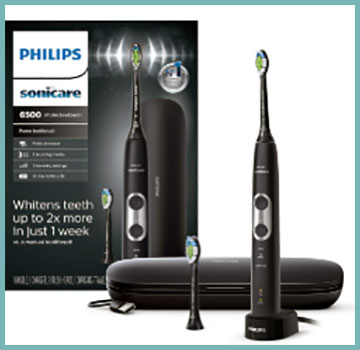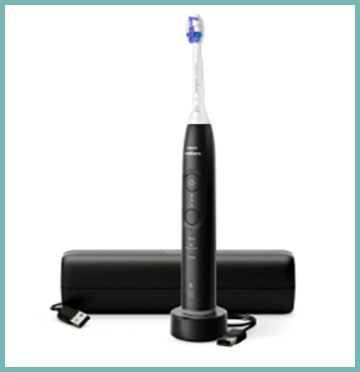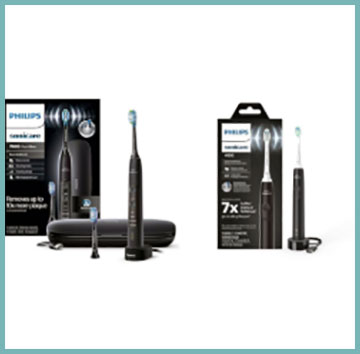As a dental enthusiast who’s spent years testing toothbrushes, I’ve put the Philips Sonicare ProtectiveClean 6500 and ExpertClean 7500 through their paces to help you decide which is worth your investment. Both models promise a superior clean, but their differences in features, performance, and value could sway your choice.
In this article, I’ll share my hands-on experience, break down their pros and cons, and compare them head-to-head to guide you toward the best pick for your oral health needs. Let’s explore what sets these two apart and which one suits you best.
A Brief Comparison Table
| Feature | Philips Sonicare 6500 | Philips Sonicare 7500 |
|---|---|---|
| Cleaning Modes | 3 (Clean, White, Gum Care) | 4 (Clean, White+, Gum Health, Deep Clean+) |
| Intensity Levels | 3 | 3 |
| Brush Heads Included | 2 C2 Diamondទ DiamondClean | 1 C3 Premium Plaque Control, 1 G3 Premium Gum Health |
| Pressure Sensor | Vibration and light ring | Smart sensor with power reduction |
| Bluetooth Connectivity | Yes, basic logging | Yes, with real-time coaching via app |
| Timer | 2-minute with QuadPacer | 2-minute with 6-area pacer |
| Battery Life | Up to 3 weeks | Up to 2 weeks |
| Travel Case | USB charging travel case | USB charging travel case |
| Weight | 1.28 lbs | 1.08 lbs |
| Colors Available | Black, White, Blue | Black, White, Pink, Blue, Deep Purple |
| Price (Approx.) | $120–$150 | $180–$220 |
My Experience With Sonicare 6500

When I first unboxed the Philips Sonicare ProtectiveClean 6500, its sleek navy blue handle caught my eye. It felt sturdy, with a slightly thicker grip that sat comfortably in my hand, making it easy to maneuver during brushing.
The sonic technology, delivering up to 62,000 brush movements per minute, gave my teeth a noticeably cleaner feel compared to manual brushing. After a week, I could see a reduction in surface stains from my daily coffee habit, especially when using the White mode paired with the C2 DiamondClean brush head.
The three cleaning modes—Clean, White, and Gum Care—offered solid versatility.
Clean mode was my go-to for daily use, providing a thorough two-minute session with a QuadPacer that vibrated every 30 seconds to guide me through each quadrant of my mouth.
The White mode, with its slightly longer cycle, tackled stains effectively, while Gum Care mode was gentle yet firm, perfect for my sensitive gums.
The three intensity settings allowed me to dial down the power when my gums felt tender, which was a lifesaver during a recent bout of sensitivity.
The pressure sensor, which pulses and lights up a ring at the handle’s base, kept me in check when I got too enthusiastic with my brushing. I appreciated the BrushSync technology, which alerted me via a beep and handle indicator when it was time to replace the brush head—typically every three months in my case.
The USB charging travel case was a game-changer for weekend trips, letting me charge the brush without lugging a separate stand. The battery lasted nearly three weeks on a single charge, even with twice-daily use, which impressed me for its reliability.
However, the 6500 isn’t perfect. The buttons and LEDs are clustered closely together, which sometimes made it tricky to switch modes without accidentally changing the intensity.
The Bluetooth connectivity, while functional, only logged basic data like brushing time and pressure, which felt underwhelming compared to more advanced models. Still, the 6500 delivered a consistently clean mouthfeel, and its ergonomic design made it a joy to use daily.
Read More: My Thoughts On Sonicare C3 Vs. G3 Vs. W3
Pros Of Sonicare 6500
- Effective Cleaning: The 62,000 brush movements per minute remove up to seven times more plaque than a manual toothbrush, leaving my teeth polished and smooth.
- Versatile Modes: Three cleaning modes (Clean, White, Gum Care) cater to daily cleaning, stain removal, and gentle gum care, fitting most oral health needs.
- Customizable Intensity: Three intensity levels let me adjust the brushing power, which was great for days when my gums felt sensitive.
- Pressure Sensor: The vibrating handle and light ring alert me when I’m brushing too hard, protecting my gums from overzealous scrubbing.
- Long Battery Life: Up to three weeks of use on a single charge made it reliable for extended periods without needing a recharge.
- Travel-Friendly: The USB charging travel case is compact and convenient, allowing me to charge on the go without extra accessories.
- BrushSync Technology: The replacement reminder ensured I swapped out worn brush heads, maintaining optimal cleaning performance.
- Affordable Price: At $120–$150, it offers premium features at a more accessible price point than higher-end models.
Cons Of Sonicare 6500
- Limited App ntact: The Bluetooth connectivity only logs basic data, lacking real-time feedback or detailed brushing insights.
- Button Layout: The closely spaced buttons and LEDs can be confusing, making it easy to accidentally switch settings during use.
- Brush Head Cost: Replacement C2 DiamondClean heads are pricey, and non-Philips options lack RFID compatibility for BrushSync features.
- Noisy Operation: The sonic vibrations are louder than some competitors, which might bother users sensitive to noise.
- Basic Color Options: Only three colors (black, white, blue) limit aesthetic choices compared to models with more variety.
Maintenance Tips For Sonicare 6500

- Regular Brush Head Replacement: Swap out the C2 DiamondClean heads every three months or when BrushSync alerts you to maintain cleaning efficacy.
- Clean the Handle: Wipe the handle with a damp cloth weekly to remove toothpaste residue, ensuring the buttons and LEDs stay functional.
- Rinse Brush Heads Thoroughly: After each use, rinse the brush head under running water to prevent plaque buildup and prolong its lifespan.
- Charge Properly: Use the USB charging travel case or standard charger, avoiding overcharging by unplugging once the battery is G3 Premium Gum Health head was gentle yet effective, though the cost of replacements stung.
My main gripe was the handle’s slickness—without non-slip grips, it felt slippery when wet. Still, the 7500’s advanced features and thorough cleaning made it a standout, especially for tech-savvy users like me who enjoy app-driven feedback.
Pros Of Sonicare 7500
- Advanced Cleaning Modes: Four modes, including Deep Clean+, provide a thorough clean, with the three-minute cycle tackling stubborn plaque effectively.
- Smart Pressure Sensor: Automatically reduces power when brushing too hard, offering a gentler experience for sensitive gums.
- Bluetooth Coaching: The app provides real-time feedback and progress tracking, helping me refine my brushing technique.
- Premium Brush Heads: Includes C3 and G3 heads, optimized for plaque control and gum care, enhancing cleaning performance.
- Slick Handle**: Lacks non-slip grips, making it slippery when wet, especially during in-shower brushing.
- Higher Price: At $180–$220, it’s pricier than the 6500, which may not justify the added features for all users.
- Complex Pacer: The 6-area pacer can feel intrusive until you get used to its rhythm, unlike the simpler QuadPacer.
Maintenance Tips For Sonicare 7500
- Replace Brush Heads Timely: Swap C3 or G3 heads every three months or when BrushSync signals, ensuring optimal plaque and gum care.
- Clean Handle Regularly: Wipe down the handle with a soft cloth weekly to keep it free of toothpaste and maintain its sleek look.
- Rinse Brush Heads Well: Run the heads under water after each use to clear debris, preserving their effectiveness and longevity.
- Monitor Battery Health: Charge fully before travel and avoid leaving it plugged in constantly to extend battery life.
- Store in Dry Conditions: Keep the toothbrush upright in a well-ventilated area to prevent moisture damage to electronics.
- Test Smart Sensors: Monthly, check the pressure sensor by applying light pressure to confirm it reduces power as designed.
- Keep App Updated: Regularly update the Sonicare app to ensure seamless Bluetooth connectivity and access to coaching features.
Comparison With Other Brands

- Oral-B Pro 1000: Offers oscillating-rotating technology, which some studies suggest removes slightly more plaque than Sonicare’s sonic vibrations, but it’s noisier and lacks BrushSync features.
- Oral-B iO Series: Matches the 7500’s smart features with app connectivity, but its round brush heads feel less precise for gum-line cleaning compared to Sonicare’s elongated heads.
- Quip Electric Toothbrush: Sleeker and quieter but lacks the power (31,000 vibrations) and advanced sensors of both Sonicare models, making it less effective for deep cleaning.
- Burst Sonic Toothbrush: Comparable sonic technology at a lower price, but its single mode and lack of intensity settings limit versatility compared to the 6500 and 7500.
- Waterpik Sonic-Fusion: Combines brushing and flossing, which is convenient, but its bulkier design and weaker vibrations don’t match Sonicare’s cleaning precision.
- Colgate Hum: Affordable with app connectivity, but its 30,000 vibrations per minute and basic pressure sensor lag behind Sonicare’s robust performance.
- Goby Electric Toothbrush: Stylish and budget-friendly, but its single intensity and lack of smart features make it less customizable than either Sonicare model.
- Both Sonicare models out Tavares: The 6500 and 7500 outperform many competitors in cleaning power and smart features, but Oral-B’s oscillating technology might appeal to those prioritizing plaque removal. Quip and Goby are great for simplicity, but they can’t match the 6500 or 7500’s versatility. The Sonic-Fusion’s dual functionality is unique, but its brushing performance feels diluted compared to Sonicare’s focused sonic technology.
Read More: My Thoughts On Oral-B Genius X Vs. 5000
Frequently Asked Questions (FAQ)
Yes, Sonicare models vary in cleaning modes, intensity levels, smart features, and accessories, impacting performance and user experience.
The 6500 has a USB charging travel case and an extra cleaning mode (Deep Clean+), while the 6100 has a basic travel case and three modes.
The 7500 is best for tech-savvy users wanting advanced features; the 6500 suits those seeking value and performance; the 9900 Prestige tops for luxury.
The 6500 offers Bluetooth, a USB charging case, and Deep Clean+ mode, while the 5300 has basic features and no app connectivity.
Conclusion: For Sonicare 6500 And 7500
You’re now equipped to choose between the Philips Sonicare 6500 and 7500 based on your needs. If you want a reliable, cost-effective toothbrush with solid cleaning power and a long-lasting battery, the 6500 is your pick. It delivers excellent performance without breaking the bank.
If you crave advanced features like real-time app coaching, a smart pressure sensor, and an extra cleaning mode, the 7500 is worth the splurge. Both will elevate your oral health, but your budget and preference for tech will decide which one fits you best.
